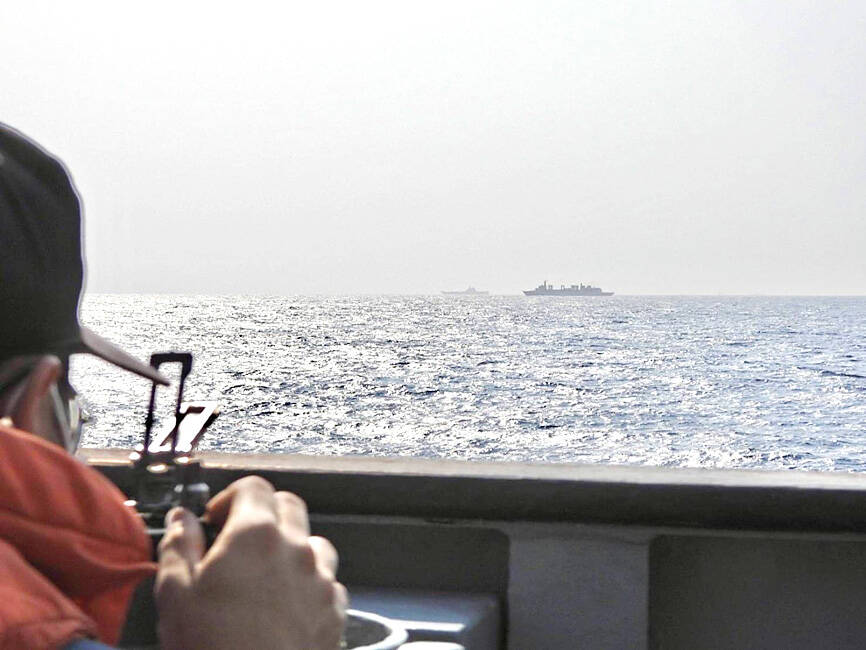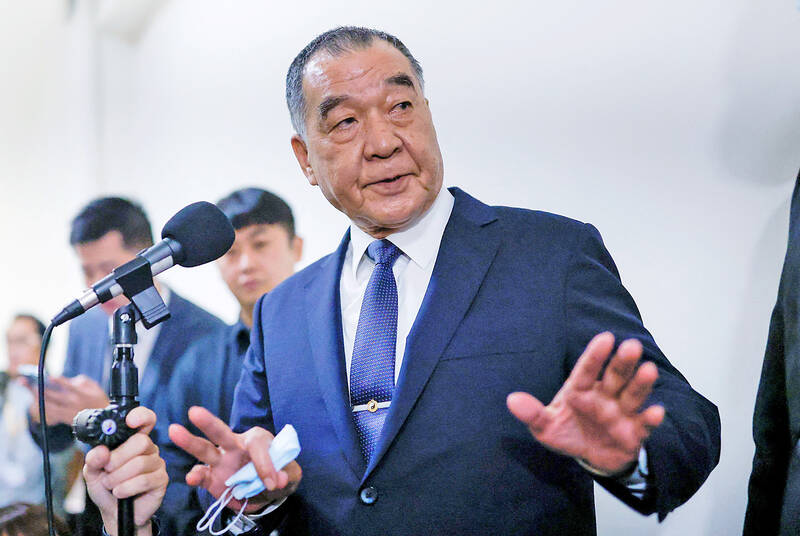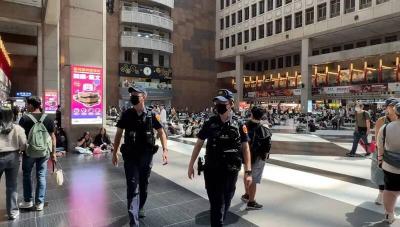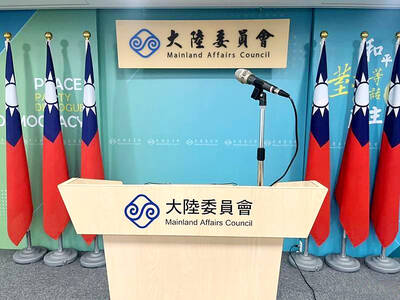The Chinese aircraft carrier Shandong is on what is expected to be a long-range training exercise about 200 nautical miles (370km) east of Taiwan, and Taiwanese naval frigates are keeping close tabs on its every move, Minister of National Defense Chiu Kuo-cheng (邱國正) said yesterday.
Since the Shandong departed from its base at Sanya Naval Port in China’s Hainan Province a few days ago, Taiwan’s armed forces have been closely monitoring its movements, Chiu told a meeting of the legislature’s Foreign and National Defense Committee.
Taiwanese forces tracked the Shandong early on Wednesday as it passed through the narrow Bashi Channel south of Taiwan and sailed into the west Pacific, where it is expected to carry out its first long-range training mission in that area, he said.

Photo courtesy of the Ministry of National Defense
The aircraft carrier was about 200 nautical miles east of Oluanipi on Taiwan’s southern tip, Chiu said.
While the ministry thinks the Shandong is there on a training mission, the military has not seen any aircraft taking off or landing on the aircraft carrier, as is expected during such exercises, he said.
The ministry does not rule out that the aircraft carrier might conduct live-fire drills near Taiwan and, as a precaution, the Taiwanese navy has dispatched several Cheng Kung-class and Lafayette-class frigates to closely monitor the Shandong, Chiu said.

Photo: REUTERS
The US nuclear-powered aircraft carrier USS Nimitz is also in the west Pacific, about 400 nautical miles east of Taiwan, he said.
The US warship is not there specifically because of the Shandong, but its deployment is “somewhat related to that,” Chiu said, without elaborating.
According to a source who asked not to be named, the USS Nimitz is conducting joint anti-submarine drills with Japanese and South Korean forces in the west Pacific.
As of press time last night, China had not released any information about the deployment of the Shandong.
On Wednesday, China’s Fujian Maritime Safety Administration (MSA) issued a statement, saying that a three-day “joint cruise and patrol special operation” was being carried out in the Taiwan Strait, led by the Haixun 06, the largest Chinese maritime patrol ship deployed to the Strait.
Starting on Wednesday, inspectors on the patrol fleet are to conduct on-site checks on vessels and construction sites in the area to make sure the ships and construction projects are operating smoothly, the MSA said.
Asked about the possibility of the Chinese patrol conducting onboard inspections of Taiwanese commercial ships, Chiu did not give a direct answer, saying only that Beijing is attempting to eliminate the median line in the Taiwan Strait and create a false impression that the waters east of the line are part of its jurisdiction.
During yesterday’s legislative meeting, National Security Bureau Deputy Director-General Henry Ko (柯承亨) told lawmakers that the Coast Guard Administration (CGA) was carrying out its own patrols and had given clear directives to Taiwanese vessels.
The Maritime and Port Bureau said in a statement on Wednesday night that it had told shippers they should reject requests from the China Coast Guard to conduct onboard inspections and immediately notify the CGA for assistance.
China must be held responsible for all liability issues arising from its unilateral implementation of such a policy, the bureau said.
The Mainland Affairs Council yesterday said that no Taiwanese ships operating in the Taiwan Strait have so far been subject to inspections by the MSA.
The council and the Maritime and Port Bureau on late Wednesday night issued separate statements, saying they solemnly protested such a unilateral action and expressed strong disapproval to counterparts in China.
The council also said in the statement that Taiwan “would be forced to respond if China insists on engaging in unilateral and unreasonable moves to impede normal cross-strait exchanges.”
Deputy Minister of Mainland Affairs Council Jan Jyh-horng (詹志宏) yesterday further criticized it as “an uncivilized move.”
“The Chinese patrol ship was not originally tasked to enforce coast guard duties, and Beijing used very vague terms to list the ship’s duties,” Jan told a news briefing in Taipei. “This would inconvenience and even interfere with vessels operating in and around the Taiwan Strait. It is not a civilized move.”
“We have been informed by the Coast Guard Administration that so far none of our ships were inspected or harassed by the Chinese patrol ship,” Jan said, adding that the CGA is closely monitoring the patrol ship’s whereabouts.
Asked about the “countermeasures” that the government would take if China insisted on inspecting Taiwanese ships, Jan said: “Should something happen, we would review the situation and respond accordingly. All we are saying is that we would respond if China disrupted the operation of our ships.”
In the past, the China Coast Guard and the CGA would conduct onboard inspections on fishing boats operating at the Taiwan Strait to deter smuggling and human trafficking, Jan said.
“Strangely, they set neither targets nor goals for the operation this time, which is to last only three days,” Jan said. “This has never happened before, and they should return to normal coast guard practices.”

A drunk woman was sexually assaulted inside a crowded concourse of Taipei Railway Station on Thursday last week before a foreign tourist notified police, leading to calls for better education on bystander intervention and review of security infrastructure. The man, surnamed Chiu (邱), was taken into custody on charges of sexual assault, taking advantage of the woman’s condition and public indecency. Police discovered that Chiu was a fugitive with prior convictions for vehicle theft. He has been taken into custody and is to complete his unserved six-month sentence, police said. On Thursday last week, Chiu was seen wearing a white

The Taoyuan Flight Attendants’ Union yesterday vowed to protest at the EVA Air Marathon on Sunday next week should EVA Airway Corp’s management continue to ignore the union’s petition to change rules on employees’ leave of absence system, after a flight attendant reportedly died after working on a long-haul flight while ill. The case has generated public discussion over whether taking personal or sick leave should affect a worker’s performance review. Several union members yesterday protested at the Legislative Yuan, holding white flowers and placards, while shouting: “Life is priceless; requesting leave is not a crime.” “The union is scheduled to meet with

‘UNITED FRONT’ RHETORIC: China’s TAO also plans to hold weekly, instead of biweekly, news conferences because it wants to control the cross-strait discourse, an expert said China’s plan to expand its single-entry visa-on-arrival service to Taiwanese would be of limited interest to Taiwanese and is a feeble attempt by Chinese administrators to demonstrate that they are doing something, the Mainland Affairs Council said yesterday. China’s Taiwan Affairs Office (TAO) spokesman Chen Binhua (陳斌華) said the program aims to facilitate travel to China for Taiwanese compatriots, regardless of whether they are arriving via direct flights or are entering mainland China through Hong Kong, Macau or other countries, and they would be able to apply for a single-entry visa-on-arrival at all eligible entry points in China. The policy aims

The government yesterday donated US$200,000 to the Philippines to support post-earthquake relief and recovery efforts, following a powerful magnitude 6.9 quake that struck Cebu Province late last month, killing at least 72 people and injuring 559 others. The donation was presented earlier yesterday by Representative to the Philippines Wallace Chow (周民淦) to Cherbett Maralit, deputy resident representative of the Manila Economic and Cultural Office, at Taiwan’s representative office in Manila. In his remarks, Chow expressed concern for those affected by the magnitude 6.9 earthquake that struck the central Philippines on the night of Sept. 30. "We sincerely hope for the earliest possible